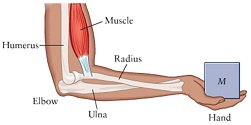Human Biomechanics Assigment
Overview
This document outlines the BME/ISE 3211 Human Biomechanics I Course Project in which biostatics analysis is used to design rehabilitation parameters for a patient with a torn distal biceps tendon. Each student will construct a free-body diagram of the human elbow/tendon system, perform static analysis of the system with an external load placed in the hand, calculate theoretical tendon tensions for a set of specified angles and loads, display data graphically, and design rehabilitation parameters within constraints set by an injury specialist. A formal report is to be submitted to a dropbox on Pilot with all relevant info and conclusions.
Background
You are a consulting biomedical/industrial engineer assisting an employer in a prominent regional manufacturing company. An employee has torn a distal biceps tendon and must undergo rehabilitation. An injury specialist has performed tests and advises that the injured tendon should not be subjected to forces exceeding 650 N during rehabilitation.
The employee’s job requires routine handling of parts ranging from 3-6 kg. During manipulation of these parts, the employee must extend the arm with supinated palm and hold the forearm in a horizontal position such that the small angle between the long axis of the upper arm and the forearm ranges from 15°-75°. Your task is to perform biostatics analysis to determine if any of these loads causes tendon tension to exceed the value advised by the injury specialist. From this analysis, you will prepare a report for submission to the employer.
Theoretical System Parameters for Biostatics Analysis
Fig. 1 shows a pictorial diagram of the extended forearm holding a load in the supinated hand.

Fig. 1: Pictorial diagram of the extended forearm handling a variable mass.
Assume that the axis of rotation of the elbow is fixed at point O and the attachment point of the distal biceps tendon is located at point A, a = 5.7 cm from O. The mass of the entire forearm including hand is mB = 1.66 kg and its center of gravity is located at point B, b = 21.0 cm from O. Define the load in the hand as mC; its center of gravity is located at point C, c = 40.6 cm from O. Define FM as the biceps tendon tension. Assume that the line of action of FM is parallel to the long axis of the upper arm throughout the specified range of motion.
Therefore, define ? as the angle FM makes with the forearm; i.e., with respect to horizontal.
Report Guidelines
1) Prepare an electronically-generated free-body diagram of the system utilizing the parameters outlined above. You may use shapes in MS Word or the drawing program of your choice. Include all dimensional information and a coordinate system.
2) Derive an expression for the magnitude FM in terms of ? and mC. Hint: you only need one rotational equilibrium equation to do this.
3) Compute FM for each of seven masses placed in the hand [mC = 3.0, 3.5, 4.0, 4.5, 5.0, 5.5, and 6.0 kg] at each of seven angles of distal biceps tendon tension [? = 15, 25, 35, 45, 55, 65, and 75°]. Prepare a table with these 49 values of distal biceps tendon tension, with ? placed along the x-axis (columns) and mC placed along the y-axis (rows). Label and caption this table. Highlight values that exceed the limit advised by the injury specialist in a suitable color.
4) Generate a graph with seven smoothed-line scatter plots (including data points) showing FM (y) vs. ? (x) for each of the seven masses using Excel or MatLab. Draw a heavy line on the graph in a suitable color indicating the tension limit advised by the specialist. Likewise, generate a similar graph showing FM (y) vs. mc (x) for each of the seven angles and a line indicating the advised tension limit. Label and caption both graphs.
5) Prepare a formal report in MS Word and submit a .docx file with the following sections:
• Cover Page
o name of the university and department
o title of the report
o submitted by: (your name)
o submitted to: (Dr. Joe Tritschler)
o date of submission
• Introduction and Purpose
o You may paraphrase the description of the problem in this assignment, but don’t simply copy and paste it.
• Data and Results
o Include all diagrams, derivations, equations, tables, and charts.
• Discussion
o Discuss the figures in the table and charts and address the following questions:
– What happens to the theoretical magnitude of distal biceps tendon tension as the arm becomes fully extended; i.e., ? approaches zero degrees?
– What does this suggest about the limitations of our analysis?
• Conclusions and Recommendations
o Should the injured employee undergo on-the-job rehabilitation?
o Specify design parameters for a rehabilitation algorithm based on your computations.
 24/7 online -
24/7 online -  1-316-444-1378 or 44-141-628-6690
1-316-444-1378 or 44-141-628-6690 Login
Login
 August 4th, 2017
August 4th, 2017  admin
admin 
 Posted in Uncategorized
Posted in Uncategorized  Free revisions
Free revisions Free title page
Free title page Free Bibliography and Reference Pages
Free Bibliography and Reference Pages Free Formatting (APA, MLA, Chicago, Harvard and Others)
Free Formatting (APA, MLA, Chicago, Harvard and Others)